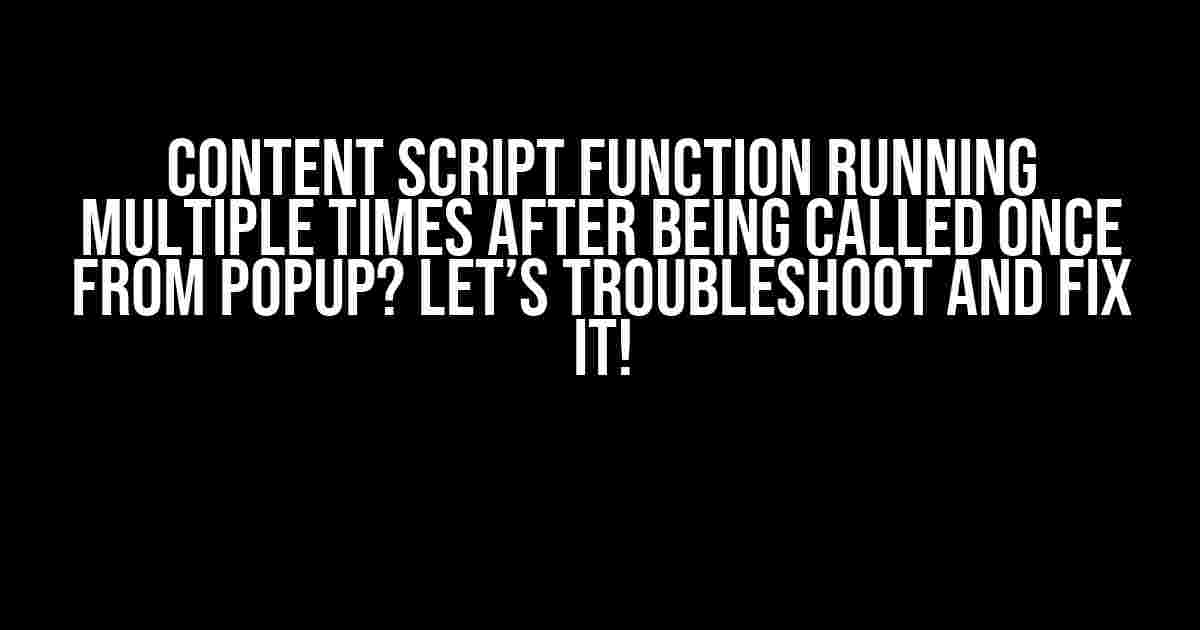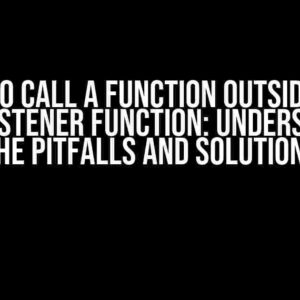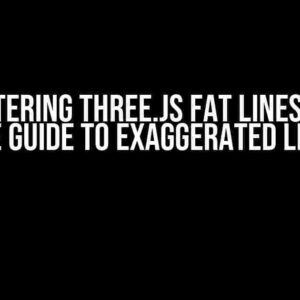Are you frustrated with your Content Script Function running multiple times after being called once from a popup? You’re not alone! This issue can be frustrating, but don’t worry, we’re here to help you troubleshoot and fix it. In this article, we’ll dive into the reasons behind this issue and provide a step-by-step guide to resolve it.
- What is a Content Script Function?
- The Issue: Content Script Function running multiple times
- Troubleshooting Steps
- Solution 1: Use a Flag to Prevent Multiple Executions
- Solution 2: Use a Semaphore
- Solution 3: Use a Callback Function
- Solution 4: Handle Event Listeners Properly
- Best Practices
- Conclusion
What is a Content Script Function?
A Content Script Function is a JavaScript function that runs in the context of a web page, allowing you to interact with the page’s content. It’s a powerful tool for web scraping, automation, and more. However, when it comes to calling these functions from a popup, things can get a bit tricky.
The Issue: Content Script Function running multiple times
When you call a Content Script Function from a popup, you expect it to run once and complete its task. However, in some cases, the function might run multiple times, causing unwanted behavior and errors. This issue can occur due to several reasons, including:
- Asynchronous execution: Content Script Functions are executed asynchronously, which means they can run multiple times if not handled properly.
- Popup lifetime: Popups have a limited lifetime, and when they’re closed, the Content Script Function might be called again, causing multiple executions.
- Event listeners: Improperly handled event listeners can cause the Content Script Function to run multiple times.
Troubleshooting Steps
Before we dive into the solutions, let’s go through some troubleshooting steps to identify the root cause of the issue:
- Check the browser console: Open the browser console and inspect the output. Are there any errors or warnings related to the Content Script Function?
- Verify the popup code: Inspect the code that calls the Content Script Function from the popup. Is it properly handling the function call?
- Use a debugger: Set a breakpoint in the Content Script Function and debug it. This will help you understand the execution flow and identify any potential issues.
Solution 1: Use a Flag to Prevent Multiple Executions
One simple solution is to use a flag to prevent multiple executions of the Content Script Function. Here’s an example:
let executed = false;
function contentScriptFunction() {
if (!executed) {
// Your code here
executed = true;
}
}
In this example, we set a flag `executed` to `false` initially. When the Content Script Function is called, it checks the flag. If it’s `false`, it executes the code and sets the flag to `true`. This ensures that the function runs only once.
Solution 2: Use a Semaphore
A semaphore is a more advanced approach to handle concurrent executions. Here’s an example:
let semaphore = 0;
function contentScriptFunction() {
if (semaphore === 0) {
semaphore++;
// Your code here
semaphore--;
}
}
In this example, we use a semaphore variable to control the execution of the Content Script Function. When the function is called, it checks the semaphore value. If it’s 0, it increments the semaphore and executes the code. Once the code is executed, it decrements the semaphore. This ensures that only one execution occurs at a time.
Solution 3: Use a Callback Function
Another approach is to use a callback function to handle the execution of the Content Script Function. Here’s an example:
function contentScriptFunction(callback) {
// Your code here
callback();
}
In this example, we pass a callback function to the Content Script Function. When the function is called, it executes the code and calls the callback function. This ensures that the function runs only once and provides a way to handle the execution result.
Solution 4: Handle Event Listeners Properly
Improperly handled event listeners can cause the Content Script Function to run multiple times. Make sure to remove event listeners when they’re no longer needed:
document.addEventListener('DOMContentLoaded', function() {
// Your code here
document.removeEventListener('DOMContentLoaded', arguments.callee);
});
In this example, we add an event listener to the `DOMContentLoaded` event and remove it once the event is triggered. This ensures that the event listener is not triggered multiple times.
Best Practices
To avoid the Content Script Function running multiple times, follow these best practices:
- Use a single instance: Ensure that only one instance of the Content Script Function is created and used.
- Handle events properly: Use event listeners wisely and remove them when they’re no longer needed.
- Use a flag or semaphore: Implement a flag or semaphore to control the execution of the Content Script Function.
- Test and debug: Thoroughly test and debug your code to identify and fix any issues.
Conclusion
In conclusion, a Content Script Function running multiple times after being called once from a popup can be frustrating, but it’s easy to troubleshoot and fix. By following the solutions and best practices outlined in this article, you’ll be able to resolve the issue and ensure that your Content Script Function runs smoothly and efficiently.
| Solution | Description |
|---|---|
| Flag | Use a flag to prevent multiple executions of the Content Script Function. |
| Semaphore | Use a semaphore to control the execution of the Content Script Function. |
| Callback Function | Use a callback function to handle the execution of the Content Script Function. |
| Event Listeners | Handle event listeners properly to prevent multiple executions of the Content Script Function. |
By implementing these solutions and following best practices, you’ll be able to resolve the issue and enjoy a seamless experience with your Content Script Function.
Still having trouble? Feel free to ask in the comments section below, and we’ll be happy to help!
Frequently Asked Question
Got questions about content script functions running amok? We’ve got answers!
Why does my content script function run multiple times after being called once from a popup?
This might be due to the way popup scripts are injected into the page. When a popup is created, the content script is injected multiple times, causing the function to run repeatedly. To avoid this, you can use a flag to track whether the function has already been executed, or use a more efficient method of injecting the script, like using a singleton pattern.
How can I troubleshoot the issue of multiple function executions?
To debug this issue, try adding console logs or breakpoints within your function to see when and how many times it’s being called. You can also inspect the HTML element that the script is being injected into, to see if there are multiple instances of the script being loaded. This should give you a better understanding of what’s causing the function to run multiple times.
Can I use a timer or interval to prevent the function from running multiple times?
While it’s technically possible to use a timer or interval to prevent the function from running multiple times, it’s not the most elegant or efficient solution. Instead, consider using a more robust approach, such as the singleton pattern, to ensure that the function is only executed once. Timers and intervals can add complexity and make your code harder to maintain, so it’s best to explore other options first.
How do I implement the singleton pattern to prevent multiple function executions?
To implement the singleton pattern, create a global variable that tracks whether the function has already been executed. Then, wrap your function in a conditional statement that checks this variable before executing the function. If the variable is true, skip the function execution. This ensures that the function is only executed once, even if the script is injected multiple times.
Are there any other potential causes for content script functions running multiple times?
Yes, there could be other reasons why your content script function is running multiple times. For example, if you’re using a framework or library that injects scripts multiple times, or if you have multiple instances of the same script running on the page. It’s essential to investigate and understand the root cause of the issue to find the most effective solution.



